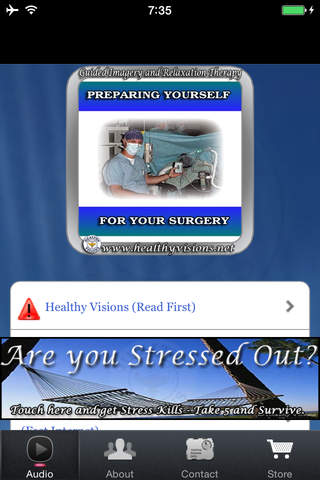
Preparing For Surgery app for iPhone and iPad
Developer: Michael Eslinger
First release : 16 Oct 2014
App size: 48.83 Mb
Preparing Yourself For Your Surgery
By M. Ron Eslinger, RN, CRNA, APN, MA, BCH, FNCH
In 1982 Ron Eslinger recorded his first "Preparing for Surgery and During Surgery" audio tracks.
In 2000, Blue Shield of California reported they had a new tactic to ease surgery: The insurer sends members a 20-minute guided-imagery audio track. Patients listen to it several times before surgery.
A soothing voice instructs them to visualize an operating room complete with a team of competent surgeons and a cheering section of their family and friends. Next, it guides them into a recovery room where they calmly awaken as their body continues to heal.
It sounds a little strange, but studies have shown that patients who listen to the audio experience less anxiety before surgery, and less blood loss and pain after surgery.
They even need less medical care and medication. According to the National Institutes of Health, relaxation techniques such as guided imagery and hypnosis are excellent for stress reduction and pain management.
Research associated with this product:
The Effects of Guided Imagery on Post-Operative Outcomes in Patients Undergoing Same-Day Surgical Procedures
Authors:
Capt Eric A. Gonzales, RN, BSN, NC, USAF
Capt Rachel J.A. Ledesma, RN, BSN, NC, USAF
Capt Danielle J. McAllister, RN, BSN, CEN, NC, USAF
Lt Col (sel.) Susan M. Perry, CRNA, MS, NC, USAF
Lt Col Christopher A. Dyer, CRNA, MS, NC, USAF
CDR John P. Maye, CRNA, PhD, NC, USN
Capt Michael R. Eslinger, CRNA, MA, NC, USN, Retired
Affiliation: Uniformed Services University of the Health Sciences
Introduction: Guided imagery, a form of relaxation using deliberate daydreaming, is a complementary therapy often utilized by anesthesia providers which can positively impact peri-operative outcomes. While several investigations have suggested guided imagery improves peri-operative outcomes in the inpatient settings, there is limited research into the value and feasibility in the ambulatory surgery realm. The purpose of this investigation was to evaluate the effects of guided imagery on postoperative outcomes in patients undergoing same day surgical procedures.
Conclusion: The utilization of Guided Imagery in the ambulatory surgery setting, even when initiated just prior to surgery, can significantly reduce preoperative anxiety which can result in less postoperative pain and earlier PACU discharge times.
Testimonials:
I recently had liposuction surgery and the anesthesiologist (who is now a certified hypnotherapist) let me listen to both of your surgical Audio Tracks. Following the surgery, everyone said that they had never had any recovery like I had...no pain, and feeling well. I really believe it was due to these Audio Tracks. -Anita
I never did tell you that I DID listen to your pre/post surgery Audio Track before and after surgery and I did very, very well. I dont recall having any serious pain--maybe just a little discomfort but nothing a few pain pills couldnt handle. I remember my two C-sections as being considerably worse. Even though Im 20 years older, I healed very quickly--the doctor was even surprised--and went back to work in less time than predicted (he released me 4-1/2 weeks after surgery instead of 6 weeks). In truth, I could have come back to work sooner than that...but I enjoyed my time at home and milked it for all it was worth! -Joanne



